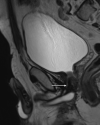MRI in patients with urethral stricture: a systematic review
- PMID: 33226004
- PMCID: PMC7837724
- DOI: 10.5152/dir.2020.19515
MRI in patients with urethral stricture: a systematic review
Abstract
Magnetic resonance imaging (MRI) is gaining acceptance as a diagnostic tool in urethral stricture disease. Numerous publications emphasize on the advantages of MRI including its ability to determine periurethral spongiofibrosis, thus overcoming the main limitation of retrograde urethrography (RUG). It is also becoming an alternative for sonourethrography (SUG), which is a highly subjective examination. Magnetic resonance urethrography (MRU) has become an increasingly appreciated tool for diagnosing patients with urethral stricture disease. Obtained data provides radiologists and urethral reconstructive surgeons with additional information regarding anatomical relationships and periurethral tissue details, facilitating further treatment planning. Considering the great prevalence of urethral stricture disease and necessity of using accurate, and acceptable diagnostic method, this review was designed to provide radiologists and clinicians with a systematic review of the literature on the use of MRI in the urethral stricture disease.
Conflict of interest statement
The authors declared no conflicts of interest.
Figures








Similar articles
-
Imaging in urethral stricture disease: an educational review of current techniques with a focus on MRI.Abdom Radiol (NY). 2023 Mar;48(3):1062-1078. doi: 10.1007/s00261-022-03761-5. Epub 2023 Jan 28. Abdom Radiol (NY). 2023. PMID: 36707430 Review.
-
Retrograde urethrography, sonouretrography and magnetic resonance urethrography in evaluation of male urethral strictures. Should the novel methods become the new standard in radiological diagnosis of urethral stricture disease?Int Urol Nephrol. 2021 Dec;53(12):2423-2435. doi: 10.1007/s11255-021-02994-5. Epub 2021 Oct 2. Int Urol Nephrol. 2021. PMID: 34599423 Free PMC article.
-
Comparison of sonoelastography with sonourethrography and retrograde urethrography in the evaluation of male anterior urethral strictures.Turk J Urol. 2016 Jun;42(2):84-91. doi: 10.5152/tud.2016.99223. Turk J Urol. 2016. PMID: 27274893 Free PMC article.
-
Sonourethrography in the evaluation of anterior urethral stricture.J West Afr Coll Surg. 2012 Jan;2(1):1-13. J West Afr Coll Surg. 2012. PMID: 25452974 Free PMC article.
-
Ultrasound imaging of male urethral stricture disease: a narrative review of the available evidence, focusing on selected prospective studies.World J Urol. 2024 Jan 13;42(1):32. doi: 10.1007/s00345-023-04760-x. World J Urol. 2024. PMID: 38217706 Free PMC article. Review.
Cited by
-
Mesh Graft Urethroplasty-Still a Safe and Promising Technique in Mostly Unpromising Complex Urethral Strictures.J Clin Med. 2022 Oct 11;11(20):5989. doi: 10.3390/jcm11205989. J Clin Med. 2022. PMID: 36294313 Free PMC article. Review.
-
Periurethral abscess etiology, risk factors, treatment options, and outcomes: A systematic review.Curr Urol. 2023 Jun;17(2):100-108. doi: 10.1097/CU9.0000000000000159. Epub 2022 Oct 12. Curr Urol. 2023. PMID: 37691985 Free PMC article.
-
Imaging in urethral stricture disease: an educational review of current techniques with a focus on MRI.Abdom Radiol (NY). 2023 Mar;48(3):1062-1078. doi: 10.1007/s00261-022-03761-5. Epub 2023 Jan 28. Abdom Radiol (NY). 2023. PMID: 36707430 Review.
-
Investigating the Outcomes and Complications of Urethroplasty Using Different Graft Materials in Men With Complex or Recurrent Urethral Strictures.Cureus. 2025 Jun 16;17(6):e86119. doi: 10.7759/cureus.86119. eCollection 2025 Jun. Cureus. 2025. PMID: 40677476 Free PMC article.
-
Urethrocystography: a guide for urological surgery?Diagn Interv Radiol. 2023 Jan 31;29(1):9-17. doi: 10.5152/dir.2022.21640. Epub 2022 Dec 21. Diagn Interv Radiol. 2023. PMID: 36959709 Free PMC article.
References
-
- Jordan GH, Schlossberg SM. Surgery of the penis and urethra. In: Wein AJ, et al., editors. Campbell-Walsh Urology. 9th ed. Vol. 1. Philadelphia, Pa: WB Saunders Co; 2007. pp. 1023–1097.
Publication types
MeSH terms
LinkOut - more resources
Full Text Sources
Other Literature Sources

